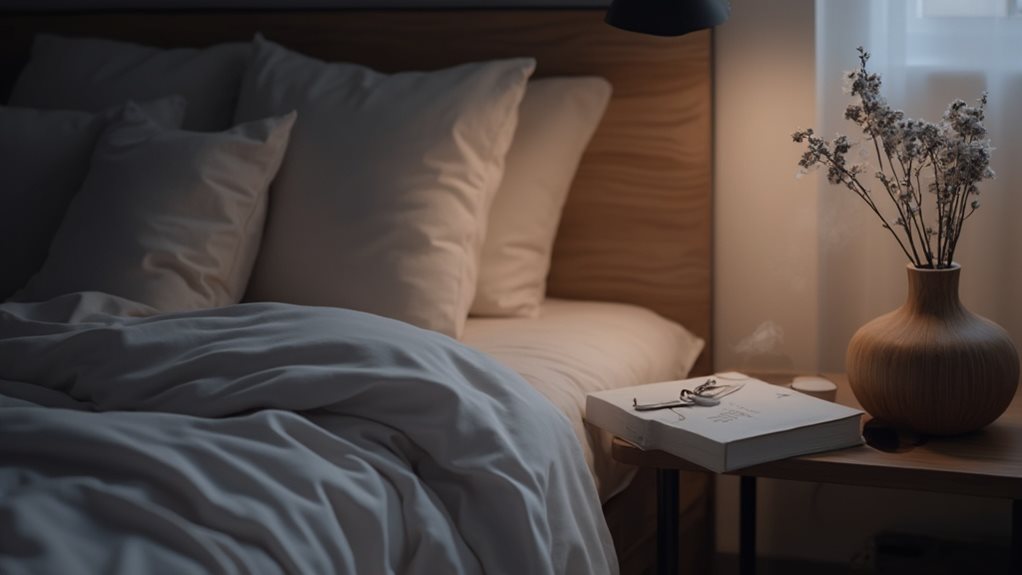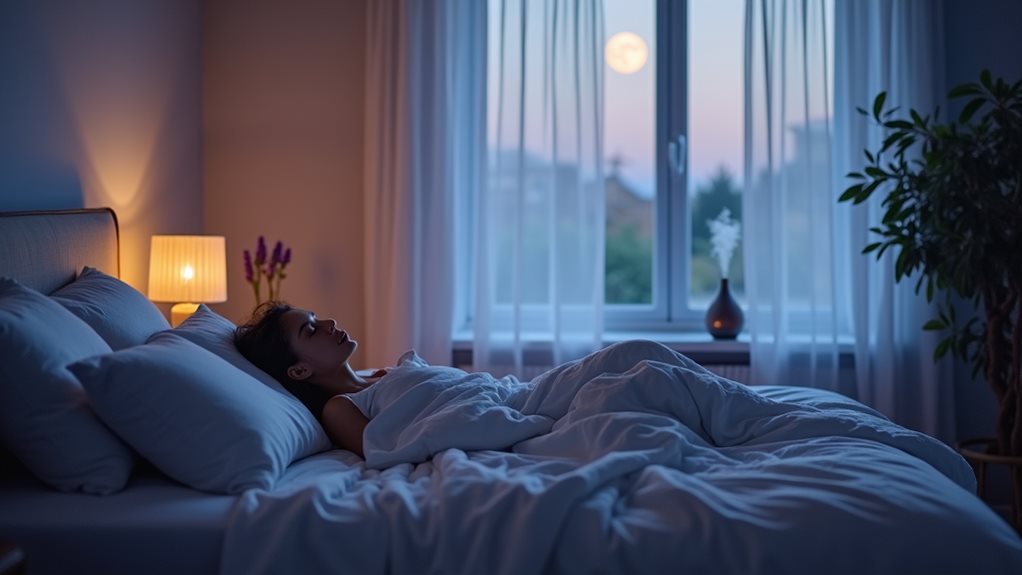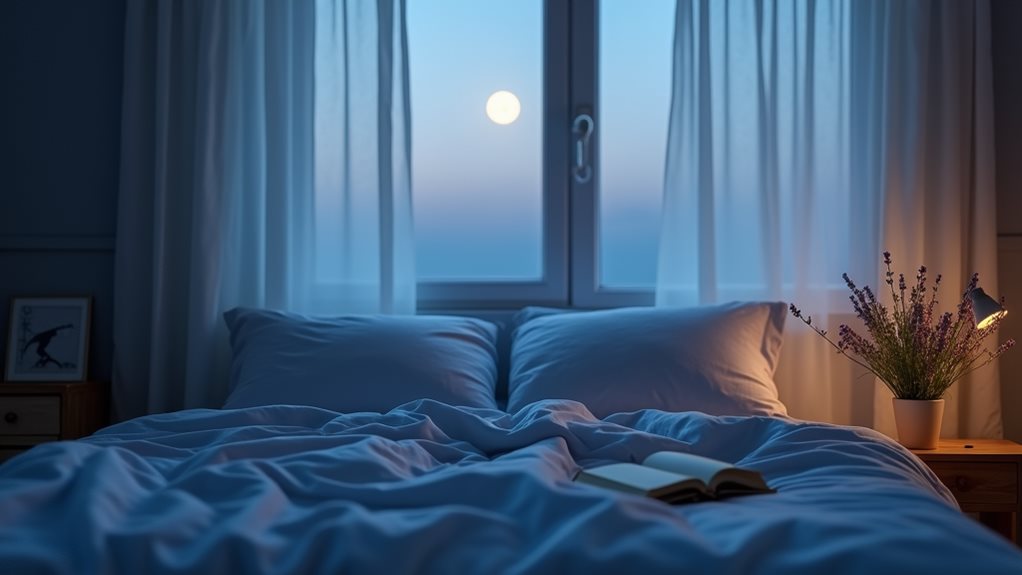
Self-hypnosis techniques effectively combat insomnia by inducing a state of deep relaxation and managing stress. Incorporating breathing exercises, visualizations, and mindfulness into your nightly routine can greatly enhance your ability to relax and prepare for sleep. Consistent practice of self-hypnosis not only eases the shift into sleep but also improves overall sleep quality. By mastering these techniques, you can access restful sleep and discover further strategies to sustain it night after night.
Key Takeaways
- Self-hypnosis involves deep breathing to regulate stress responses, promoting relaxation before sleep.
- Visualization exercises in self-hypnosis divert focus from anxieties to calming scenarios.
- Regular self-hypnosis practice at bedtime establishes a consistent sleep-inducing ritual.
- Incorporating personal relaxation triggers into self-hypnosis enhances the sleep transition process.
- Self-hypnosis addresses the root causes of insomnia, facilitating deeper, more restful sleep.
Exploring the Connection Between Stress and Insomnia
While many factors contribute to insomnia, stress stands out as a particularly potent trigger.
Stress management and sleep hygiene are crucial in mitigating its effects. Effective stress management reduces the physiological arousal that delays sleep onset. Techniques such as deep breathing and meditation can soothe the mind, preparing it for rest.
Concurrently, good sleep hygiene—maintaining a consistent sleep schedule, creating a restful environment, and avoiding stimulants before bedtime—enhances the quality of sleep.
Together, these practices form an all-encompassing approach, addressing both the mental and environmental factors that contribute to insomnia, thereby promoting a more relaxed and restorative sleep experience.
The Role of Cognitive Therapy in Sleep Improvement
Cognitive therapy plays an essential role in improving sleep by addressing the psychological barriers that contribute to insomnia. It involves the practice of cognitive restructuring to change unhelpful thought patterns that disrupt sleep.
Here are key components:
- Identification of Negative Thoughts: Recognizing and addressing beliefs that hinder sleep.
- Cognitive Restructuring: Replacing these thoughts with more balanced and positive perspectives.
- Behavioral Techniques: Developing habits that promote better sleep hygiene.
- Stress Reduction: Using therapeutic methods to lower anxiety that affects sleep.
This structured approach helps individuals develop healthier mental frameworks, leading to improved sleep patterns and overall well-being.
Mastering Relaxation: Techniques for Effective Self-Hypnosis

Mastering relaxation through self-hypnosis begins with understanding and applying specific techniques that facilitate a deep state of calm.
Essential to this process are breathing techniques and visualization exercises. Focused breathing helps regulate the body's response to stress, guiding the mind into a tranquil state.
Concurrently, visualization exercises enhance this effect by engaging the imagination to conjure peaceful scenes or experiences, effectively diverting attention from daily anxieties.
These methods not only promote relaxation but also prepare the mind and body for a rejuvenating sleep, addressing the root causes of insomnia and enhancing overall sleep quality through gentle, self-directed practice.
Integrating Mindfulness and Meditation Into Your Nightly Routine
Integrating mindfulness and meditation into your nightly routine can greatly enhance the quality of your sleep. By adopting these practices, individuals can effectively manage stress and prepare their minds and bodies for rest.
Here are key steps to incorporate:
- Dedicate time each evening for mindful breathing, focusing solely on the rhythm of inhales and exhales.
- Engage in evening reflection, reviewing the day's events calmly and without judgment.
- Gradually shift into a meditative state, using guided imagery or silence to deepen relaxation.
- Consistently practice these techniques at the same time each night to establish a calming bedtime ritual.
Maintaining Consistent Sleep Patterns Through Self-Hypnosis Practice

While self-hypnosis has been shown to improve sleep quality, maintaining consistent sleep patterns requires regular practice and dedication.
Individuals can enhance their sleep habits by identifying personal relaxation triggers that facilitate the change into sleep. Incorporating these triggers into nightly routines as part of self-hypnosis practice can greatly stabilize sleep cycles.
Methodically training the mind to respond to these relaxation cues helps in establishing a rhythm conducive to restful sleep.
Frequently Asked Questions
Can Self-Hypnosis Be Effective for Those With Chronic Insomnia?
Self-hypnosis techniques can be effective for individuals suffering from chronic insomnia by inducing relaxation, targeting negative thoughts, and promoting healthier sleep patterns, thereby enhancing overall sleep quality and daily functioning. Regular practice is recommended.
How Long Does It Typically Take to See Results From Self-Hypnosis?
How quickly can one expect improvements? The duration for self-hypnosis to show results varies, typically ranging from a few days to weeks, depending on individual commitment and the consistency of practice in sleep improvement techniques.
Are There Any Risks Associated With Using Self-Hypnosis for Sleep?
Self-hypnosis for sleep is generally considered safe. However, individuals with severe mental health disorders should consult professionals. Potential side effects are rare but could include increased anxiety or discomfort during initial practices.
Can Self-Hypnosis Replace Sleep Medications?
While self-hypnosis might not entirely replace sleep medications for everyone, its profound benefits offer a compelling alternative. This method enhances relaxation, addresses insomnia's cognitive aspects, and fosters healthier sleep habits without pharmacological side effects.
How Do Age and Health Conditions Affect Self-Hypnosis Effectiveness?
Age-related factors and health-specific challenges can influence the effectiveness of self-hypnosis, with older adults and those with certain medical conditions potentially experiencing variations in responsiveness to self-hypnosis techniques. Adaptations may be necessary for ideal results.
Conclusion
As night descends like a soft velvet curtain, self-hypnosis offers a lantern to guide the weary through the labyrinth of wakefulness into the serene sanctuary of sleep. By weaving cognitive threads into a tapestry of tranquility, this practice not only quiets the clamorous mind but also harmonizes the body's rhythms. Embracing these techniques nightly carves a path to restorative slumber, illuminating the journey towards holistic health and a peaceful mental landscape, night after peaceful night.





